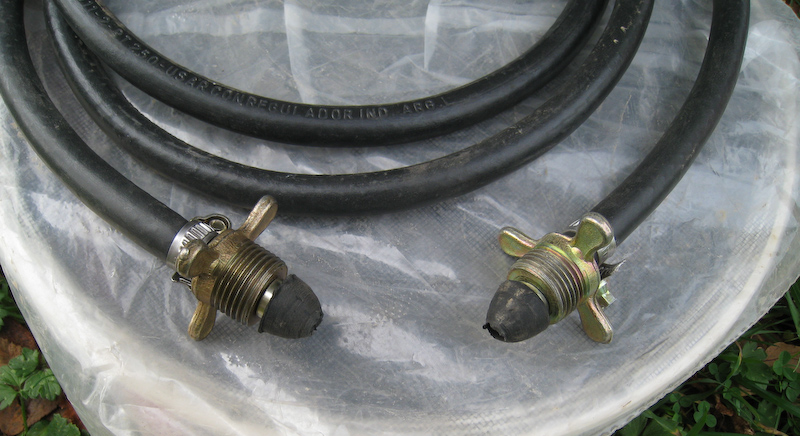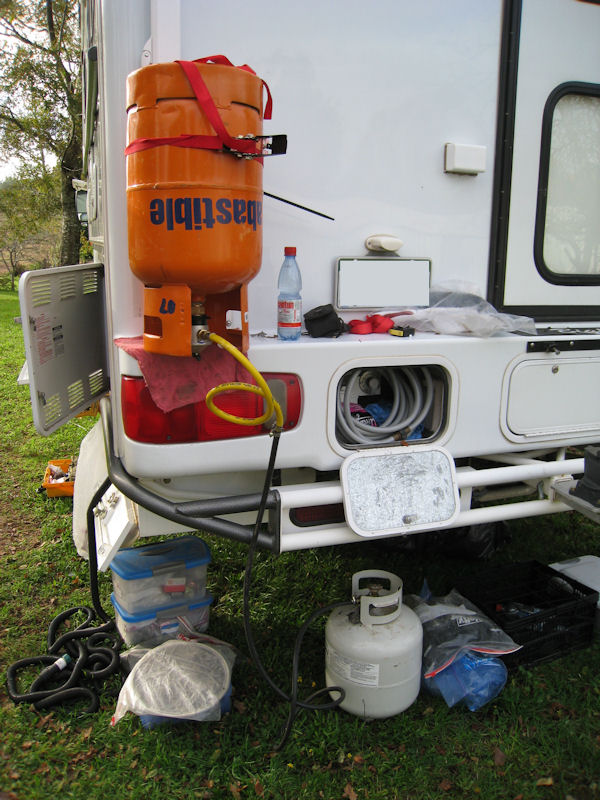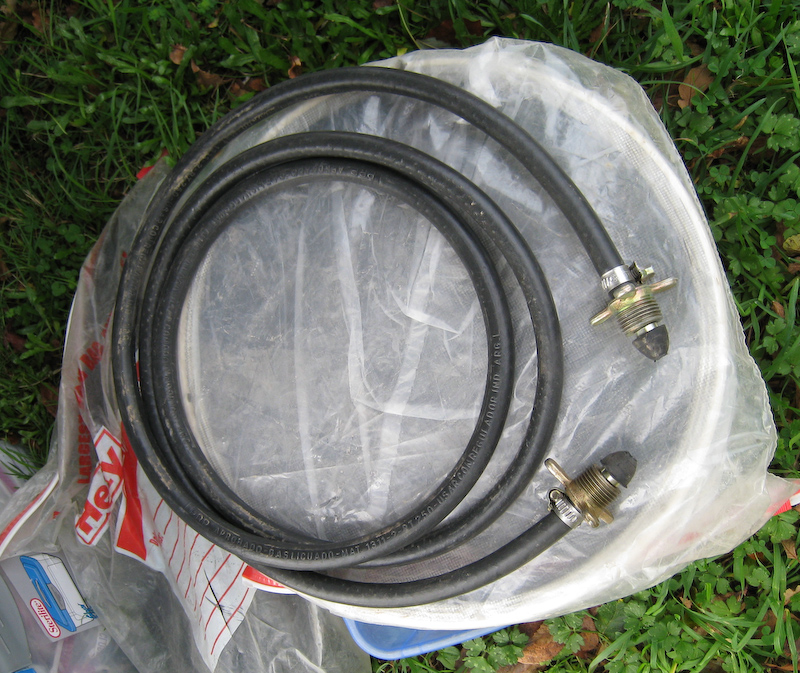
West Union, Illinois | I posted a reply yesterday, but apparently Wild Blue shot it off into space somewhere. Just to clarify what you want to do, you want to salvage the remaining propane from a 20# cylinder into another 20# or maybe larger cylinder, correct? Yes, it is doable with gravity. not necessarily quickly, but doable. The big thing is to make sure the receiving tank has the capacity to hold the extra fuel. All you will need is a hose MADE FOR LIQUID PROPANE with POL fittings on each end. I emphasized the propane part because you REALLY NEED to use LP hose. "Ought to work" will get someone hurt. For instance, anhydrous hose and propane hose are not inerchangable. It needs to be stamped on the side of the hose it is for fuel gas. Do it correctly the first time. Being a farmer you'll hang the hose up on a nail and 5 years from now go "I've got one of those someplace". Do it right now so nobody gets hurt later. Oh, and one of these if you are trying to transfer from one of the newer tanks with the outside right hand thread fittings ... this probably won't work. When you turn it over the overfill valve will most likely shut off the flow. Not always, but commonly.
You may have to buy a hose for a BBQ grill and modify one end of it. It will look something like this: 
I stumbled across a camper forum where doing this was discussed, so rather than plant the same row twice I'll copy from them. (The thread was about filling from an LP tank in Chile (the country), so I am deleting a few things not relevant to this discussion) From http://www.expeditionportal.com/forum/showthread.php?t=15060: When using a jumper fill, do the following:
Prerequisites:
A) Realize this is a dangerous procedure. You are dealing with explosive materials that can kill you and those around you.
B) Protect your hands. Liquid propane/LP is very, very cold when it evaporates (changes from a liquid to gas state). It will quickly freeze your skin and tissue, faster than you can react and pull away.
C) Extinguish all flames and eliminate all potential sources of sparks, flames, cinders, hot ash, etc.
D) Ensure the feeder tank has more than enough liquid propane/LP to fill the target tank.
E) Ensure you have a high output valves (POL) and high capacity hose (3/8") on the feeder tank to target tank jumper connection.
Process:
1. Do the transfer outside, in an area with good ventilation and air flow.
2. Secure all connections and check for leaks.
3. Invert the feeder tank. This puts the liquid gas (Liquid Petroleum Gas = LPG = LP) at the bottom of the feeder tank.
4. Raise the feeder tank to a level above the target tank. Secure the feeder tank to a solid object using a ratchet strap, tie down strap, etc.
5. Open the target tank valve.
6. Open the feeder tank valve.
7. If possible, create a temperature difference between the two tanks. Your goal is to make the target tank cooler than the feeder tank. For instance, locate the target tank in the shade and the feeder tank in the sun. Or, put a damp towel on the target tank. Or, pour warm water on the feeder tank.
Propane/LP sees a lower temp area as a lower pressure area and seeks to migrate towards it. Creating a temperature delta between the two tanks will help you achieve a higher fill of the target tank.
8. DO NOT fill to 100%. Stop your fill at 80% to allow for gas expansion at higher ambient temperatures. Overfilling the target tank can cause it to explode at high ambient temperatures if sufficient gas is not used from the tank prior to high temperature exposure. Note that modern U.S.A. tanks with small ACME thread (1 3/8” right hand thread) valves have an automatic valve shut off at 80% full.
Propane expands 1.5% per 10 degrees F. A propane tank filled to 100% at 0 degrees F in Minnesota could become dangerously over-pressurized if taken to 100-degree F Arizona.
Weight is the only way to measure how full you have the tank.
Propane weighs 4.2 pounds per US gallon / .51 kilograms per liter, at 60 degrees Fahrenheit / 15.5 Centigrade.
Every propane tank is stamped with its tare weight (the weight of the tank itself) and its liquid water capacity. You need to calculate the weight of the tank if filled to 100% and 80% capacity. The total weight is tare weight + (tank liquid capacity * weight per liquid unit).
Again, weight is the ONLY way to know how full you have the tank.
If you are working with a modern U.S. tank it SHOULD shut off the fill valve at 80%. Don't bet your life on it always working.
If you are working with a tank from another country, you MUST weigh it to know how full it is.
Here's a sample of the basic setup.

Note the inverted feeder tank in the sun, target tank in the shade, etc. Also note that this test proved unsuccessful. It is not possible to jumper fill from a Chilean quick disconnect valve, it won't pass enough liquid propane.

POL to POL jumper hose

POL to POL jumper hose connector detail. This hose was constructed with components purchased at a small hardware store in Perito Moreno, Argentina.
Be careful, be methodical, and this is no big deal. Screw around  and you will pay the price. Chances are you will only get one chance to screw it up. and you will pay the price. Chances are you will only get one chance to screw it up.
Edited by Mike SE IL 8/5/2009 07:00
|


 transfering propane from one tank to another
transfering propane from one tank to another